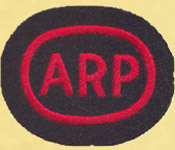
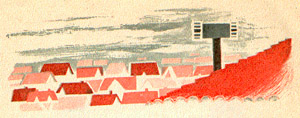


Before the Second World War there was no system for warning the general population of an impending air raid other than with hand bells, rattles and whistles as had been used in the Great War.
 |
 |
 |
In 1938-9 a national warning system based on sirens to warn of air attack was implemented.
Two types of siren were used, manual hand operated used in rural areas or temporary military and civillian sites and electrically operated for use in urban areas.
The manually operated type were portable and included a lightweight stand and a single hand turned impeller or fan which produced one note, the frequency of which depended on the speed of which the handle was rotated.
The electrically operated type were fixed and usually mounted on the top of a high building often a Police Station, Fire Station or Town Hall. If there were no convenient building, on a high pole.

Advertisment from Daily Mail September 4 1939
Due to the design of the impeller and its housing the air output was cut on and off alternately thus producing the basis of sound production.

Assuming a motor rotational speed of 2840 rpm the output frequency would be 473.33 and 568 Hertz, a sound that would become very familiar to civilians 1939-1945. (It used to scare the wits out of me!)
To convey a state of "ALL CLEAR" the siren was switched on to produce a steady note. To convey a state of "TAKE COVER" a device was wired into the motor circuit which cut the power supply for a short while at intervals thus allowing the motor speed to drop and then rise again when reconnected.
These devices were commonly supplied with two push buttons.
One, "TAKE COVER" the Red Warning, which brought into
use the automatic cut-outs.
The other White Warning for "ALL CLEAR" or "RAIDERS
PAST" which over-rode the cut-outs and produced
a steady note.
Air Raid Warning Control Units

 |
The Waterloo siren is situated on the bridge
support on the north side of the bridge that crosses York Road.
|
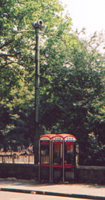 |
The Kensington Gardens siren is at the
just about opposite Queensway tube station on the Bayswater Road. The Black Lion Gates park gates are nearby. |
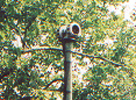 |
Detail of Kensignton Gardens siren. |
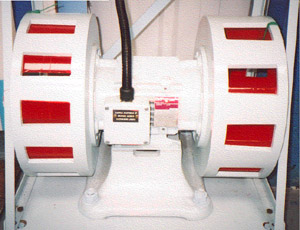
The Siren
There was a continuous programme of care and maintenance and over the
years most of the original sirens would have been replaced with later models.
This one being manufactured by Castle Castings around 1987/8.
Click here to see picture of the The Control Panel.
The contractor who had the job of removing them in Sussex kindly donated
the siren to the
Tangmere Military Aviation Museum
and was restored
by Penfolds of Barnham
(Restored and I think the Broad Arrow is poetic licence!)
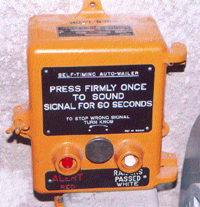
Click
here to see picture of electrically driven siren in the Kelvedon Hatch
collection
Visit the Kelvedon
Hatch website
However as the system was maintained after the war it was necessary to introduce a third warning of "NUCLEAR FALLOUT". This became the Grey Warning which was signalled on the manually operated sirens by having a shutter fitted across the air output which when closed would cause the sound output to cease.
A Grey Warning lasted 2 ½ minutes comprising 5
turns with the sound "on" and 5 turns with the sound "off". Twisting the
sleeve on the steadying handle controlled the shutter.
This warning system was possibly abandoned in 1968.
|
"Advising the Householder on Protection against Nuclear Attack" Published by HMSO 1963 RED - Siren (rising and falling note) Imminent danger of attack. GREY - Siren (interrupted note of steady
pitch) or Church bells (or, in Scotland, oral or whistle message)
BLACK - Maroon, gong or whistle sounding a Morse ‘D’ – dash dot dot. Imminent danger of fall-out ALL CLEAR – Siren (steady note) No threat of air
attack or fall-out.
|
|
Published by West Sussex County Council 2nd Edition 1980 OFFICIAL WARNINGS OF ATTACK ATTACK imminent – Sirens will sound a rising
and falling note. All radio and TV programmes will
FALLOUT warning – Three bangs or whistle blasts on quick succession. ALL CLEAR – Sirens will sound a steady note.
If your area has received fallout then it is unlikely a general
|
The need for the Grey Warning was withdrawn in 1968.
The different manufacturers can be identified easily.
The Carter has tripod angle iron legs as shown in picture below.
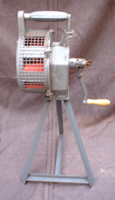
The Carter siren internally is of superior manufacture with ball race
bearings.
The Secomak has four tubular legs as shown in picture below.
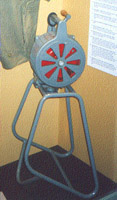
The hand operated Home Office Model c1962
Type 447 manufactured by Secomak
(Littlehampton Museum)

Instruction Card Text:-
UNITED KINGDOM WARNING AND MONITORING SYSTEM
HAND-OPERATED SIREN
Instructions for Use

2. The siren should be sounded in a position which the operator can get to immediatley, but in the open away from buildings and trees, or if possible above ground level (for example on a flat roof).
3. RED WARNING Imminent danger of attack.
The signal to be given is a rising and falling note lasting one minute.
Ensure that the shutter on the siren body remains open. Rotate the turning
handle, applying full pressure for the first five turns; for the next five
turns relax the pressure; then again apply full pressure for five turns,
and so on for one minute.
After sounding the RED warning, bring the siren back under cover, if
practicable.
4. GREY WARNING Fallout expected, but not for one hour.
The signal to be given is an interrupted note of steady pitch lasting for two and a half minutes. Rotate turning handle as fast as possible at constant speed, and while doing so operate the twist grip control on the steadying handle so that the shutter is open for five turns, then closed for five turns, and so on for two and a half minutes.
5. WHITE WARNING All clear (no threat of air attack or fallout).
The signal to be given is a steady note lasting for one minute. With the shutter open rotate the turning handle as fast as possible at constant speed for one minute.
(The crate that this siren instruction card was taken from was dated
1962)
"THE OLD CLERKENWELL SIREN REPAIR SHOP"

Click to
see picture of siren assembled and with shutter open.
Click to
see picture of siren assembled and with shutter closed.
(Twisting the sleeve on the steadying handle controls the shutter)
Packing case marked:
HAND OPERATED
SYREN
(HOME OFFICE PROPERTY)
Manufactured by Service Electric Co Ltd 1963
Pictures of boxed siren manufactured by Carter & Co
Click
her to see picture of boxed siren
Click
here to see picture of Carter's label
Due to their isolated locations the electrically operated sirens were subject to icing up. Fitting heaters solved this. Nesting birds presented another problem; this was solved by wire netting.
Although no doubt responsible for saving countless lives, the coverage by this type of warning in an environment of rising background noise and increased home insulation, particularly double glazing, was questioned.
During the Cold War period there were 7000 electrically operated and 11000 hand operated sirens.
With the wider use of radio and television communication the system based on the siren was abandoned in 1992.
A few lasted a little longer as flood warning and other local emergency purposes in some areas.
The Historic Dockyard in Portsmouth still have a siren and sound it periodically. I hope to locate, determine type and purpose and photograph it soon.
My thanks to the staff at Tangmere Military Aviation Museum for their interest and help.
Sirens are common in rural Germany and are used to alert the Freiwillige Feuerwehr (Volunteer Fire Service) and for any other Emergency.
Click
here to see the siren atop the local government offices of Nachterstedt,
to
the east of the Harz mountains
Click
here for a close up
Click
here to see the siren mounted on the roof of the Town Hall in Buggingen
in the Black Forest.
Click
here for a close up.
Siren in France.
Click
here to see French Siren overlooking Nice Harbour.

All colour pix © Roy Smith
Page updated 21 November 2004